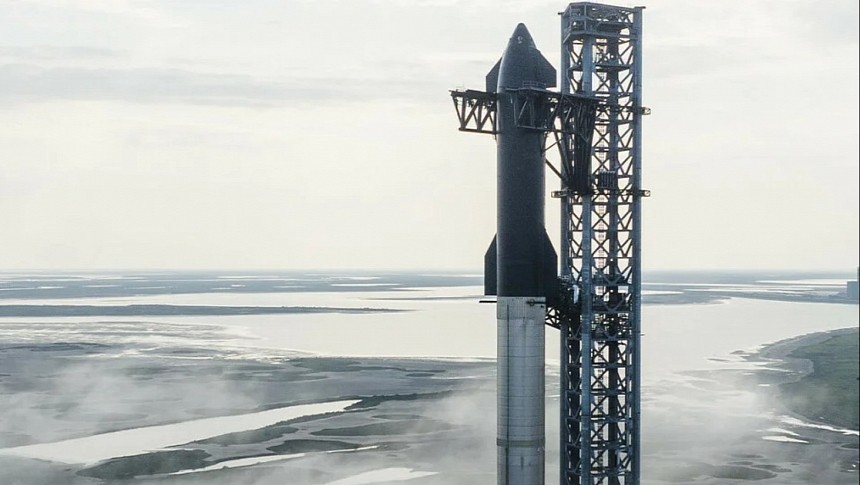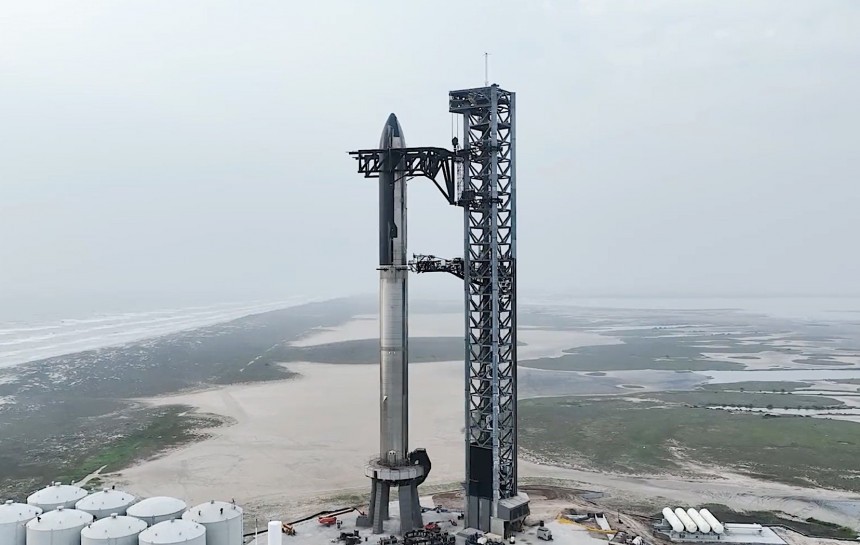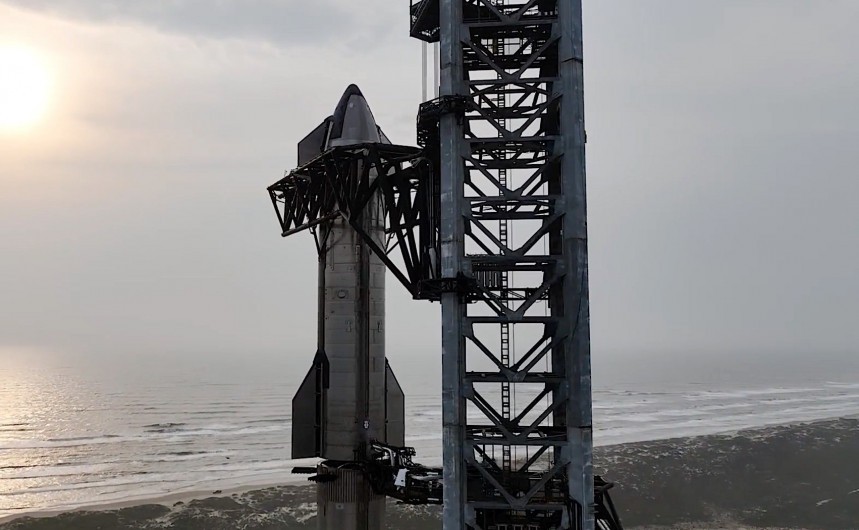It might be easy to mock SpaceX at times for any number of reasons. For its larger-than-life character of a 21st-century venture capitalist of a leading man or the drama surrounding Elon Musk's other billion-dollar companies. Take your pick for any negative attribute surrounding the company that built Starship, the most powerful rocket ever assembled. But even if you can't stand Tesla, SpaceX, or anything Musk-adjacent, you shouldn't be too harsh on Starship booster B4 and spacecraft S20 scrubbing its first launch attempt.
After a pressure valve-related anomaly in Starship booster B4's labyrinth of liquid oxygen feed lines, SpaceX opted not to risk even the remote chance of a catastrophic incident taking place on the platform's very first orbital test flight. The reaction to the incident on social media tended to range from mild amusement at Elon Musk's misfortune to quipping about the proposed next launch attempt date being April 20th. Yup, Starship's very first orbital test flight might take place on 4/20. Talk about blazing it to the max.
Update: SpaceX eventually attempted the launch on April 20th, resulting exactly in the disastrous outcome they wanted to avoid in the first place.
But before you mock SpaceX as many did with NASA after its three back-to-back launch scrubs of Artemis I last year, we urge you to refrain from taking to your keyboards just yet. In spite of everything negative that you could say about SpaceX or any single person who works for the company, you should give Starship a chance. In truth, the online human-crewed spaceflight fandom space has had a real negative Nancy complex lately. As a website that reported live at the first two Artemis I in the summer of last year, we've seen firsthand how badly people can react to back-to-back heartbreaking launch aborts.
Strictly from our own impression during our coverage at Cape Canaveral during Artemis I, local bars along the Space Coast were full of people bemoaning how NASA "dropped the ball" christening the new flagship SLS booster rocket. Some even declared NASA may as well concede the Moon to Russia and China and call it quits altogether. In a way, it's not hard to understand why someone would make such a grandiose statement immediately after watching the launch scrubs live.
What this means in regards to SpaceX and Starship is that the public at large can get pretty ticked off when space launches don't go right the first time. When all the misgivings of other Elon Musk-related drama in SpaceX's periphery are added to the equation, it seems to make for a pretty toxic and negative public sentiment surrounding Starship. That's in spite of how objectively amazing it is as a piece of engineering, whether you're an Elon fan or not.
Now, we should preface that we understand why people might think Starship is a ridiculous machine. Think about it for a second, 390 feet (119 m) tall, 16.7 million lbs (74.5 M.N) of thrust out of a scarcely believable 33 liquid methane and O2-powered Raptor engines? Oh, and very nearly the entirety of the vehicle is designed to be completely reusable. That sounds like something a teenager would build in Kerbal Space Program or a space travel-related Minecraft mod.
It doesn't sound like something that'd actually be practical to operate in the real world, right? Well, at least for another few days, all the speculation will remain just that. I.e., all in our heads and not any kind of proven science. In the meantime, public sentiment that Starship was the wrong choice to serve as the lunar lander vehicle for the Artemis program remains prevalent across the internet.
As recently as 2019, reports abounded that even NASA themselves were somewhat annoyed with SpaceX for somewhat dubious assumptions about when Starship will be ready to carry live astronauts into space. Of course, the subsequent global health crisis gave the perfect excuse for everybody to forget about SpaceX moving the goalposts a few times on delivery dates. But in 2023, it's the public at large, as well as NASA again, who's liable to blister SpaceX if subsequent orbital test launches continue to be scrubbed as Artemis I was.
But whichever way you slice it, whether you think Starship is an absurd machine or not, it's time we space travel junkies accept that SpaceX is going to be a vital, if not THE most vital, component to fulfilling the doctrine of the Artemis Accords. An international coalition of 23 U.S.-allied nations who've agreed to use NASA and SpaceX hardware to get a wide array of people, not just North Americans, onto the surface of the Moon and beyond within the next few years. With that being the case, all the SpaceX haters ought to be rooting for Starship to succeed instead of reveling in an albeit minor failure.
We end with a little dissertation for you all to ponder. Remember how many people hailed the SLS as a failure after three Artemis I launch scrubs? Well, you should also remember how these same people all collectively shut their mouths when the candle finally did light up.
Just remember, folks, Rome wasn't built in a day. Conversely, we're pretty confident SpaceX can fix Starship's faulty fueling hardware in time to celebrate its first successful orbital test with Snoop Dogg and Willy Nelson on their favorite day of the year.
Update: SpaceX eventually attempted the launch on April 20th, resulting exactly in the disastrous outcome they wanted to avoid in the first place.
But before you mock SpaceX as many did with NASA after its three back-to-back launch scrubs of Artemis I last year, we urge you to refrain from taking to your keyboards just yet. In spite of everything negative that you could say about SpaceX or any single person who works for the company, you should give Starship a chance. In truth, the online human-crewed spaceflight fandom space has had a real negative Nancy complex lately. As a website that reported live at the first two Artemis I in the summer of last year, we've seen firsthand how badly people can react to back-to-back heartbreaking launch aborts.
Strictly from our own impression during our coverage at Cape Canaveral during Artemis I, local bars along the Space Coast were full of people bemoaning how NASA "dropped the ball" christening the new flagship SLS booster rocket. Some even declared NASA may as well concede the Moon to Russia and China and call it quits altogether. In a way, it's not hard to understand why someone would make such a grandiose statement immediately after watching the launch scrubs live.
What this means in regards to SpaceX and Starship is that the public at large can get pretty ticked off when space launches don't go right the first time. When all the misgivings of other Elon Musk-related drama in SpaceX's periphery are added to the equation, it seems to make for a pretty toxic and negative public sentiment surrounding Starship. That's in spite of how objectively amazing it is as a piece of engineering, whether you're an Elon fan or not.
It doesn't sound like something that'd actually be practical to operate in the real world, right? Well, at least for another few days, all the speculation will remain just that. I.e., all in our heads and not any kind of proven science. In the meantime, public sentiment that Starship was the wrong choice to serve as the lunar lander vehicle for the Artemis program remains prevalent across the internet.
As recently as 2019, reports abounded that even NASA themselves were somewhat annoyed with SpaceX for somewhat dubious assumptions about when Starship will be ready to carry live astronauts into space. Of course, the subsequent global health crisis gave the perfect excuse for everybody to forget about SpaceX moving the goalposts a few times on delivery dates. But in 2023, it's the public at large, as well as NASA again, who's liable to blister SpaceX if subsequent orbital test launches continue to be scrubbed as Artemis I was.
But whichever way you slice it, whether you think Starship is an absurd machine or not, it's time we space travel junkies accept that SpaceX is going to be a vital, if not THE most vital, component to fulfilling the doctrine of the Artemis Accords. An international coalition of 23 U.S.-allied nations who've agreed to use NASA and SpaceX hardware to get a wide array of people, not just North Americans, onto the surface of the Moon and beyond within the next few years. With that being the case, all the SpaceX haters ought to be rooting for Starship to succeed instead of reveling in an albeit minor failure.
Just remember, folks, Rome wasn't built in a day. Conversely, we're pretty confident SpaceX can fix Starship's faulty fueling hardware in time to celebrate its first successful orbital test with Snoop Dogg and Willy Nelson on their favorite day of the year.
















